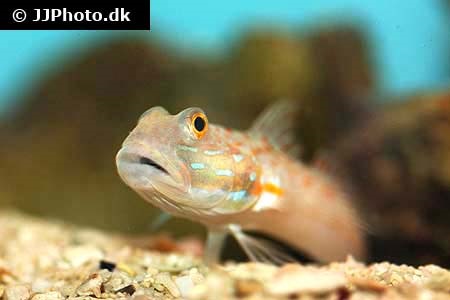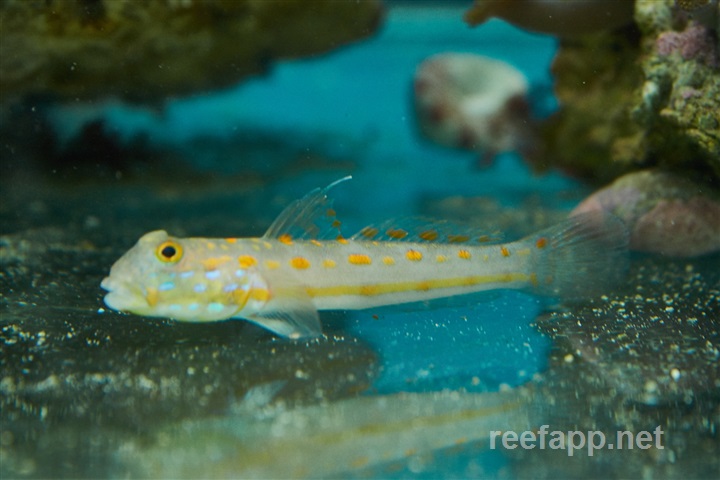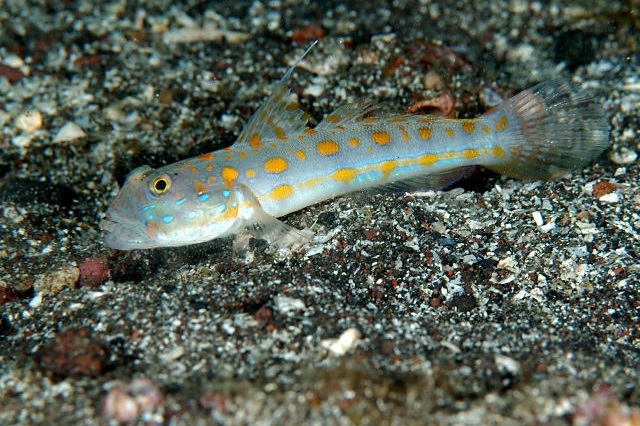Valenciennea puellaris




| Latin name | Valenciennea puellaris - (Tomiyama, 1956) |
|---|---|
| Local name | Diamond Watchman Goby |
| Family | Gobiidae - Valenciennea |
| Origin | East Indian Ocean, West Indian Ocean, Australia, Indonesia, East Pacific, Central/West Pacific |
| Max length | 17 cm (6.7") |
| Minimum volume |
500 l (132 gal) |
|---|---|
| Hardiness |
Average |
| Suitable for aquarium |
Experience, preparation and extra care required |
| Reef safe |
Reef safe with caution |
| Aggressiveness | Mostly peaceful but might be aggressive towards similar species |
| Recommended |
Small crustaceans (Krill, mysis, artemia...) Zooplankton (Cyclops, pods...) |
|---|---|
| Mostly |
Other invertebrates |
This species is known to jump out of open aquaria.
This species requires feeding 4 or more times a day.
This species likes rearranging the sand in the aquarium.
Be sure that the rocks cannot collapse if the sand is removed.
These fish assist in keeping the sandy substrate clean, by filtering sand through the gills for the food it contains.
This can lead to corals being covered with sand.
This species thrives best when there is a sufficiently large amount of micro life (copepods, amphipods or similar) in the aquarium, so that the it can always find their own food.
This species thrives best in a pair. (Male and female)
This species needs good hiding places, for example, between live rocks.
This species can be very shy when first introduced into a new aquarium.
More aggressive fish can be introduced after this species has acclimatized.
Gobies (Gobiidae) are generally small fish, which live close to the bottom. Many of the species are fairly hardy and well suited to aquaria. The behaviour of the different kinds of Gobies varies greatly and some can be very interesting.
The most common types of Gobies in aquaria are the following:
Sand eating Gobies (Amblygobius, Koumansetta and Valenciennea)
Sand eaters filter the sand through their mouths and out of their gills.
They are generally bigger than other Gobies, but they are usually peaceful, so size is not a problem.. They can however be aggressive towards their own species.
One must be aware that they can eradicate the micro life in the substrate when the tank is too small. If there is not enough live food in the sand, it can be difficult to ensure the fish stay in good condition, as they require frequent feeding.
They may spread sand across the corals when they eat.
Shrimp Gobies (Amblyeleotris, Cryptocentrus and Stonogbiops)
Shrimp Gobies have a symbiotic relationship with Pistol shrimps, but one must first find out which species can live together.
The shrimp and Goby live together in a small hole in the sand or under a stone where the shrimp maintains the hole, so it will not collapse over time. The Goby helps by looking out for enemies, since the shrimp does not see well in sunlight, as it will have become accustomed its vision to the darkness of the hole.
Neon Gobies (Elacatinus/Gobiosoma)
Thesef Gobies are very small and like the Cleaner Wrasse, it eats parasites off other fish.
These Gobies are easier to keep alive in the aquarium than Cleaner Wrasses, as they can eat a wide range of foods.
Clown Gobies (Gobiodon)
These fish are very small and therefore suitable for small aquariums. Clown Gobies will often hide inbetween the branches of stony corals, like Acropora for example.
They generally eat many types of food, as long as it is small enough.
| Aquarium trade | Yes |
|---|---|
| Distribution | Indo-Pacific: Red Sea to Samoa, north to southern Japan, south to the Great Barrier Reef and New Caledonia. |
| French common names |
Eleotris taché d'orange |
| English common names |
Orange-dashed goby Orange-spotted sleeper-goby Orangespotted glidergoby Orangespotted glider goby |
Henry C. Schultz. 2003. The Fish Of Which Dreams (or Nightmares) Are Made: The Genus Valenciennea - Reefkeeping Magazine - (English)
Scott W. Michael. Reef Aquarium Fishes: 500+ Essential-to-know Species - TFH Publications / Microcosm Ltd. - (English)
James W. Fatherree. 2011. Aquarium Fish: A Look at the Gobies - Advanced Aquarist - (English)
Bob Fenner. "True" or Combtooth Gobies, the Family Gobiidae - Wet Web Media - (English)

